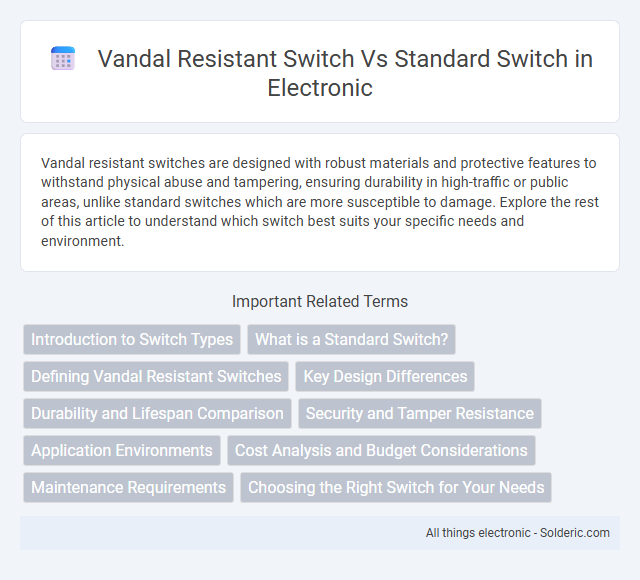Vandal resistant switches are designed with robust materials and protective features to withstand physical abuse and tampering, ensuring durability in high-traffic or public areas, unlike standard switches which are more susceptible to damage. Explore the rest of this article to understand which switch best suits your specific needs and environment.
Comparison Table
| Feature | Vandal Resistant Switch | Standard Switch |
|---|---|---|
| Durability | High resistance to physical damage, tampering, and harsh environments | Low to moderate, susceptible to damage |
| Material | Stainless steel or reinforced plastic | Plastic or standard metal |
| Protection Level | IP65 or higher (water and dust resistant) | Typically IP20 to IP44 |
| Actuation Force | Higher, to prevent accidental activation | Lower, for ease of use |
| Application | Public areas, industrial sites, vandal-prone environments | Residential, low-risk environments |
| Lifespan | Long, designed for heavy use | Shorter, less durable |
| Cost | Higher due to robust construction | Lower, standard materials |
Introduction to Switch Types
Vandal resistant switches are specifically designed with robust materials such as stainless steel and reinforced housings to withstand physical abuse and tampering, contrasting with standard switches that are typically made from less durable materials intended for regular indoor use. These switches often feature sealed components to prevent dust, moisture, and debris entry, enhancing reliability in harsh environments like public spaces or industrial settings. Standard switches, while suitable for everyday applications, lack the protective features necessary to endure intentional damage or extreme conditions.
What is a Standard Switch?
A standard switch is a basic electrical device designed to control the flow of electricity in residential or commercial wiring systems, typically featuring a plastic or metal housing without enhanced protective features. It provides simple on/off functionality but lacks reinforced materials or tamper-resistant elements found in vandal resistant switches. Standard switches are more susceptible to damage, wear, and unauthorized manipulation in high-traffic or public environments.
Defining Vandal Resistant Switches
Vandal resistant switches are specifically engineered with durable materials such as stainless steel and reinforced housings to withstand physical abuse and tampering in high-traffic or public environments. Unlike standard switches, they feature tamper-proof designs with sealed components to prevent moisture, dust, and debris ingress, ensuring reliable operation under harsh conditions. These switches are commonly used in public transportation systems, industrial control panels, and security access points to enhance longevity and security.
Key Design Differences
Vandal resistant switches feature durable materials like stainless steel and reinforced housings to withstand physical abuse, unlike standard switches with basic plastic or metal construction. Their design incorporates tamper-proof mechanisms and recessed or flush-mounted buttons to prevent forced activation or damage. You can ensure long-lasting operation in high-traffic or public areas by choosing vandal resistant switches over standard ones.
Durability and Lifespan Comparison
Vandal resistant switches are engineered with robust materials like stainless steel and reinforced housings, providing superior durability and significantly extended lifespan compared to standard switches that typically use plastic components prone to damage. The vandal resistant design prevents tampering, impact damage, and environmental wear, ensuring reliable performance in high-traffic or public areas where standard switches may fail quickly. Choosing a vandal resistant switch enhances Your system's resilience, reducing maintenance costs and downtime.
Security and Tamper Resistance
Vandal resistant switches feature robust stainless steel or reinforced polymer housings designed to withstand physical attacks, enhancing security in public or high-risk environments. These switches incorporate tamper-proof screws and recessed buttons to prevent unauthorized access and manipulation, significantly reducing the risk of vandalism compared to standard switches. Standard switches lack these protective features, making them more vulnerable to damage, tampering, and security breaches.
Application Environments
Vandal resistant switches are specifically engineered for high-traffic, public, and harsh environments such as industrial sites, transportation hubs, and outdoor installations where durability and tamper-proof features are critical. Standard switches suit controlled environments like office buildings or residential settings where mechanical abuse and vandalism risks are minimal. The robust construction and materials of vandal resistant switches ensure reliable operation under extreme conditions, whereas standard switches prioritize cost efficiency for less demanding applications.
Cost Analysis and Budget Considerations
Vandal-resistant switches typically have a higher upfront cost compared to standard switches due to their reinforced materials and tamper-proof designs, which can increase initial budget allocations. Long-term savings may result from reduced maintenance and replacement expenses caused by fewer damages and tampering incidents. Evaluating the total cost of ownership, including installation, durability, and potential downtime, is essential for budget planning in environments prone to vandalism.
Maintenance Requirements
Vandal resistant switches require significantly less maintenance compared to standard switches due to their robust, tamper-proof construction designed to withstand harsh environments and intentional damage. Their durable materials reduce the risk of component failure, minimizing downtime and the need for frequent repairs. Choosing vandal resistant switches ensures your system remains reliable with lower overall maintenance costs.
Choosing the Right Switch for Your Needs
Vandal resistant switches feature reinforced materials and tamper-proof designs that protect against physical damage and unauthorized access, ideal for high-traffic or public areas. Standard switches, while typically more cost-effective, lack these robust features and are best suited for controlled environments with minimal risk of abuse. Understanding your installation context and security requirements ensures you select a switch that balances durability, performance, and budget effectively.
vandal resistant switch vs standard switch Infographic

 solderic.com
solderic.com